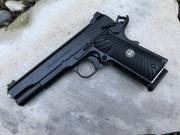
Originally Posted by
farscott

The quoted sentence exposes the snake oil. If the spring weight is lighter, where does the extra energy originate? How does that work in an AR? What gets the extra energy? Is it the bolt cycling faster?
Another way to think about it. The force of a spring is proportional to a constant times the distance the spring is compressed or stretched as long as the spring is within its elastic envelope.
Force times distance is energy. Power is energy per unit time. The spring weight is analogous to the constant. If the constant is smaller, the only way to get the same force is to increase travel. If that is not the case and travel is the same, the decreased spring weight has to result in decreased force. And that intuitively makes sense. In the rifle, the travel distance is fixed. So less energy should be the result. So how does the lighter spring result in extra energy?
The only way to have the same power with less energy for the same mass to be moved the same distance is to do the work in less time. So the rifle would have to cycle faster. That makes some sense as the same buffer is being moved the same distance. But if the rifle cycles too quickly, there are issues. So what benefit does the spring offer to the buyer? To the seller, it is obvious the spring offers a way to extract more money from the buyer.



 Reply With Quote
Reply With Quote






